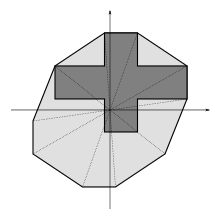Absolutely convex set
A set C in a real or complex vector space is said to be absolutely convex or disked if it is convex and balanced (circled), in which case it is called a disk. The disked hull or the absolute convex hull of a set is the intersection of all disks containing that set.
Properties
If S is a subset of a real or complex vector space X, then the following are equivalent:
- S is a disk;
- for any scalars a and b satisfying |a| + |b| ≤ 1, aS + bS ⊆ S;
- for all scalars a, b, and c satisfying |a| + |b| ≤ |c|, aS + bS ⊆ cS;
- for any scalars a1, ..., an satisfying , ;
- for any scalars c, a1, ..., an satisfying , ;
The intersection of arbitrarily many absolutely convex sets is again absolutely convex; however, unions of absolutely convex sets need not be absolutely convex anymore.
The disked hull of a set is equal to the convex hull of the balanced hull of that set; it is also equal to the intersection of all disks containing that set.
If D is an absorbing disk in a vector space X then there exists an absorbing disk E in X such that E + E ⊆ D.[1]
Convex balanced hull

Let X be a real or complex vector space. The smallest convex (resp. balanced) subset of X containing a set is called the convex hull (resp. balanced hull) of that set and is denoted by co(S) (resp. bal(S)). For any subset S of X, the convex balanced hull of S (also called the absolute convex hull, or the disked hull), denoted by cobal(S), is the smallest subset of X containing S that is convex and balanced.[2] The convex balanced hull of a set S the intersection of all absolutely convex sets containing S, analogous to the well-known construction of the convex hull. More explicitly, one can define the absolutely convex hull of the set A via where the λi are elements of the underlying field. The convex balanced hull of S is equal to the convex hull of the balanced hull of S, that is, cobal(S) = co(bal(S)).
The convex balanced hull of S contains both the convex hull of S and the balanced hull of S. The absolutely convex hull of a bounded set in a topological vector space is again bounded.
Examples
Although cobal(S) = co(bal(S)), the convex balanced hull of S is not necessarily equal to the balanced hull of the convex hull of S.[2] For an example where cobal(S) ≠ bal(co(S)), let X be the real vector space and let S := { (-1, 1), (1, 1) }. Then bal(co(S)) is a strict subset of cobal(S) that is not even convex. In particular, this example also shows that the balanced hull of a convex set is not necessarily convex. To see this, note that cobal(S) is equal to the closed square in X with vertices (-1, 1), (1, 1), (-1, -1), and (-1, 1) while bal(co(S)) is a closed "hour glass shaped" shaped subset that intersects the x-axis at the origin and is the union of two triangles: one whose vertices are the origin along with S and the other triangle whose vertices are the origin along with -S = { (-1, -1), (1, -1) }.
See also
| The Wikibook Algebra has a page on the topic of: Vector spaces |
- Balanced set
- Convex set
- Vector (geometric), for vectors in physics
- Vector field
References
- Narici 2011, pp. 149-153.
- Trèves 2006, p. 68.
- Robertson, A.P.; W.J. Robertson (1964). Topological vector spaces. Cambridge Tracts in Mathematics. 53. Cambridge University Press. pp. 4–6.
- Narici, Lawrence; Beckenstein, Edward (July 26, 2010). Topological Vector Spaces, Second Edition. Pure and Applied Mathematics (Second ed.). Chapman and Hall/CRC.
- Schaefer, H.H. (1999). Topological vector spaces. Springer-Verlag Press. p. 39.